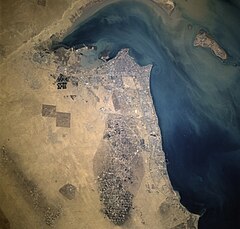Zatoka Kuwejcka
 Widok na Kuwejt wraz z zatoką z kosmosu | |
| Państwo | |
|---|---|
| Lokalizacja | |
| Wymiary | ok. 40 × ok. 15 km |
| Miejscowości nadbrzeżne | |
Zatoka Kuwejcka (arab. جون الكويت, Jūn al-Kuwayt) – zatoka w Kuwejcie o wymiarach ok. 15 na ok. 40 km. Stanowi część Zatoki Perskiej. Została uformowana przez dawne ujście rzeki Eufrat (pozostałością po nim jest wyspa Dżazirat Bubijan). Zatoka Kuwejcka jest stosunkowo płytka i położone są nad nią najważniejsze porty kraju (w południowej części), w tym stolica. W całości jest administrowana przez Kuwejt[1]. Kształt zatoki to elipsa głęboko wcinająca się w głąb lądu o mało urozmaiconym brzegu na północy i bardziej poszarpanej linii brzegowej na południu z czterema wyraźnymi półwyspami. Dzięki temu długość jej brzegu stanowi połowę długości całego wybrzeża Kuwejtu. Dostęp do zatoki w pewnej odległości od niej osłania wyspa Dżazirat Fajlaka. Charakteryzuje się dość dużym zanieczyszczeniem i powolną wymianą wód[2].
Przypisy
- ↑ Facts about Kuwait. Stała Misja Dyplomatyczna Kuwejtu przy Narodach Zjednoczonych - Genewa. [dostęp 2015-02-07]. (ang.).
- ↑ Tanuspong Pokavanich, Yousef Alosairi: Summer Flushing Characteristics of Kuwait Bay. Journal of Coastal Research - September 2014, wrzesień 2014. [dostęp 2015-02-07]. (ang.).
Bibliografia
- N. Al-Mutairi, A. Abahussain i A. Al-Battay: Environmental Assessment of Water Quality in Kuwait Bay. IJESD. [dostęp 2015-02-07]. (ang.).
Media użyte na tej stronie
Kuwait City, Al Burqan Oil Field, Kuwait - November 1996
image description from [1]:
STS080-733-021 - "The Al Burqan Oil Field, the largest oil and gas field in the world, can be seen in this north-looking view. The oil-free desert sands are visible surrounding the large oil field complex. This was the site in early 1991 of over 530 oil well fires started by the invading Iraqi troops and engineers as part of their country’s “scorched-earth policy.” The oil well fires were extinguished in November of 1991. Five years later, pools or lakes of oil are visible throughout the oil field. Many of the wells have been put back into service. The country of Kuwait possesses about one-fifth of the world’s oil reserves. To the north of the Al Burqan Oil Field, Kuwait City is discernible. New pivot-irrigation fields (dark circular features) developed since the end of the Gulf War are visible to the west (left) of the city. Oil refineries and large tanker facilities are discernible along the Persian Gulf coast." Photo center Latitude: 29.5, Longitude: 48.0


